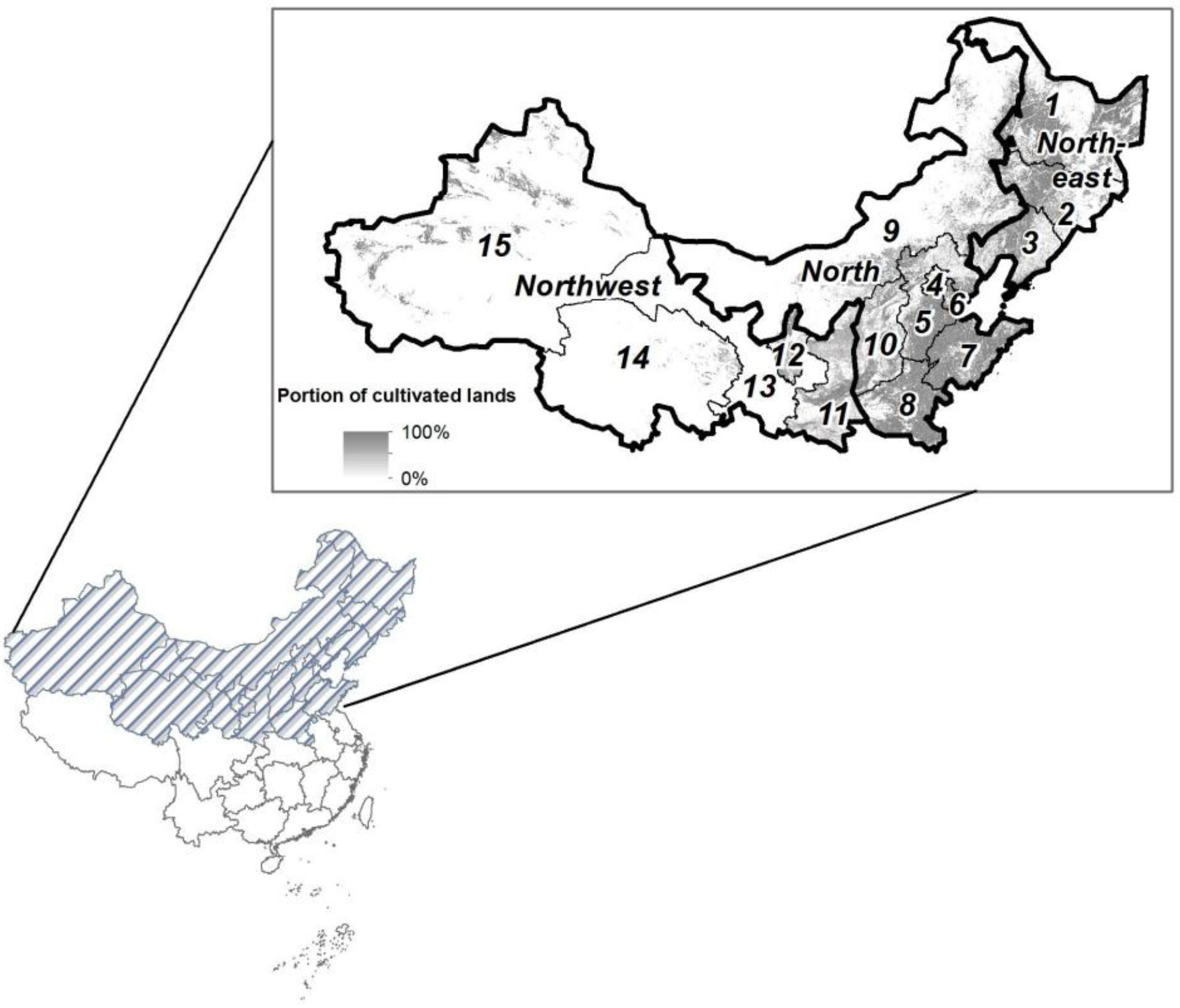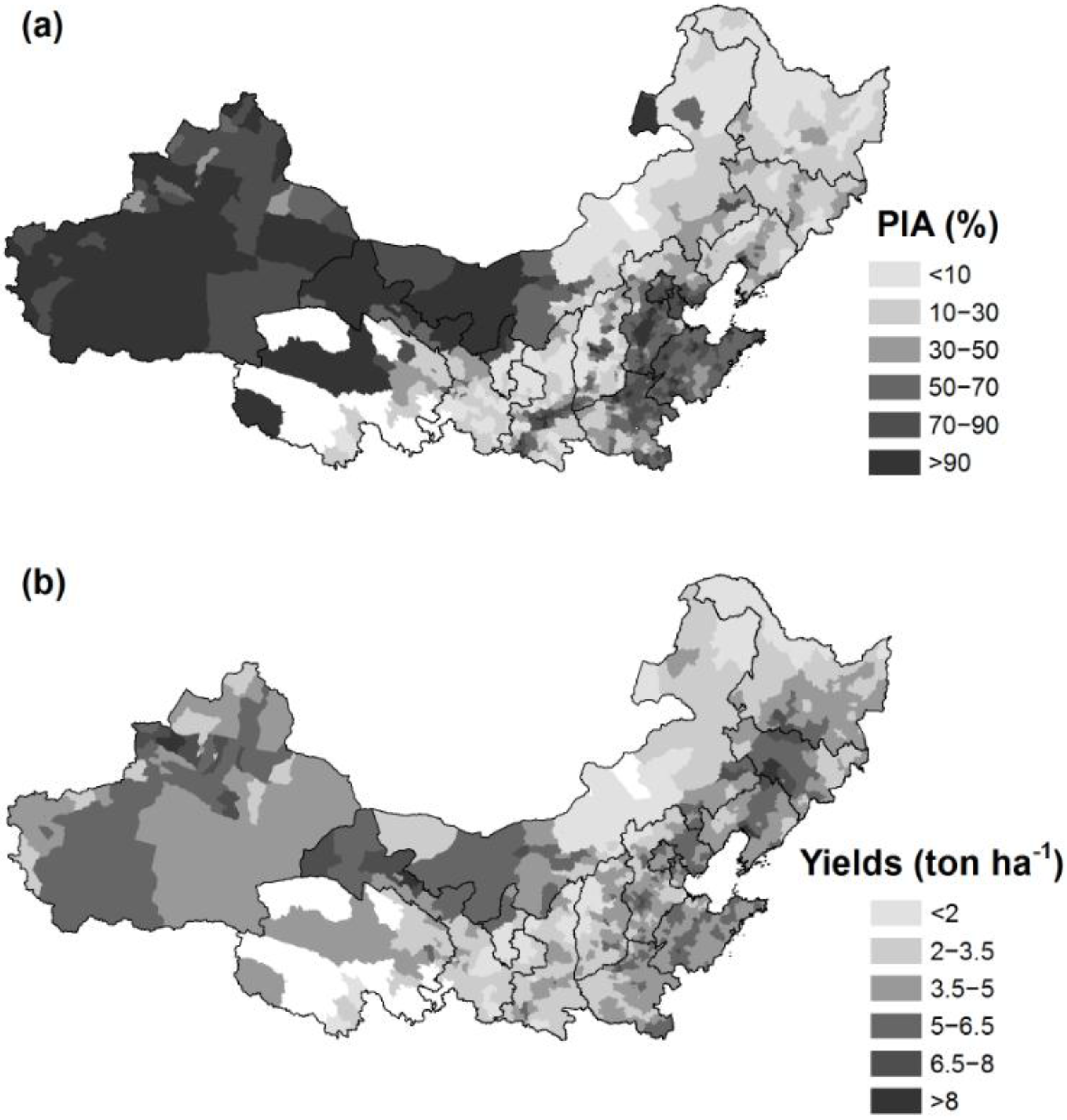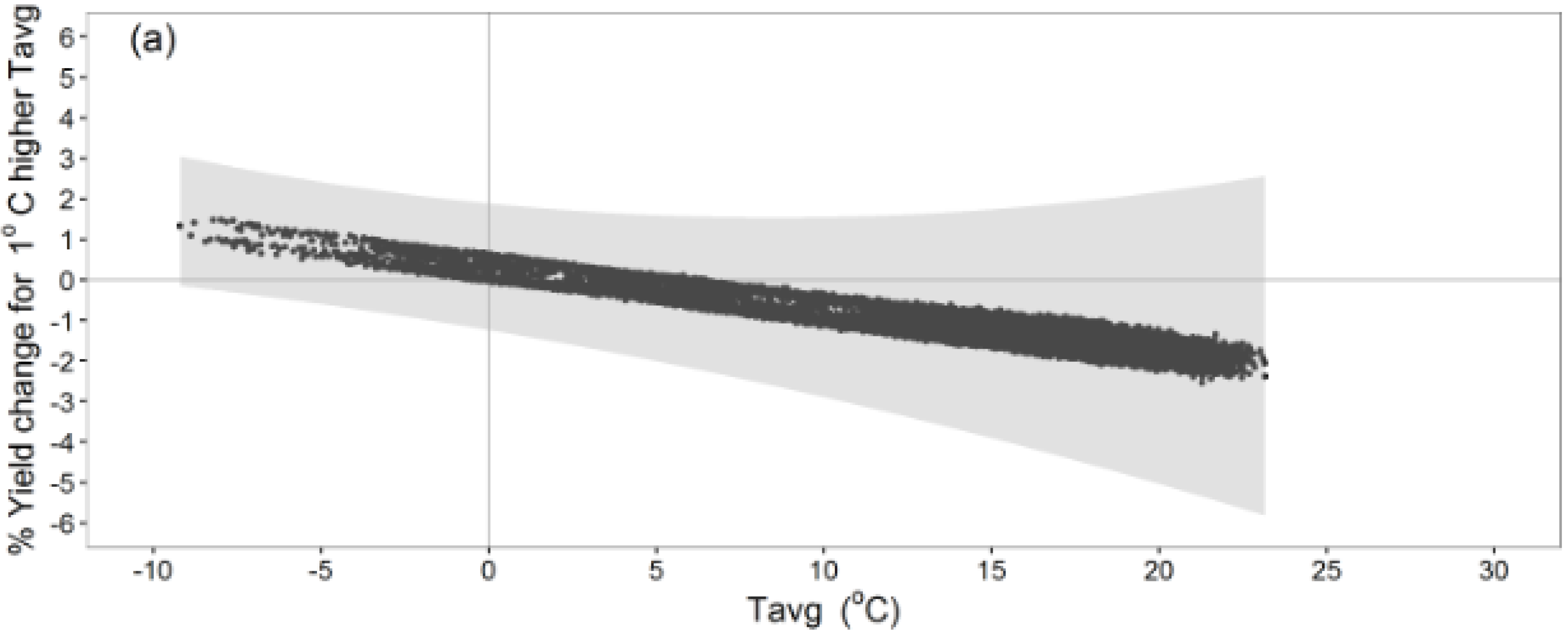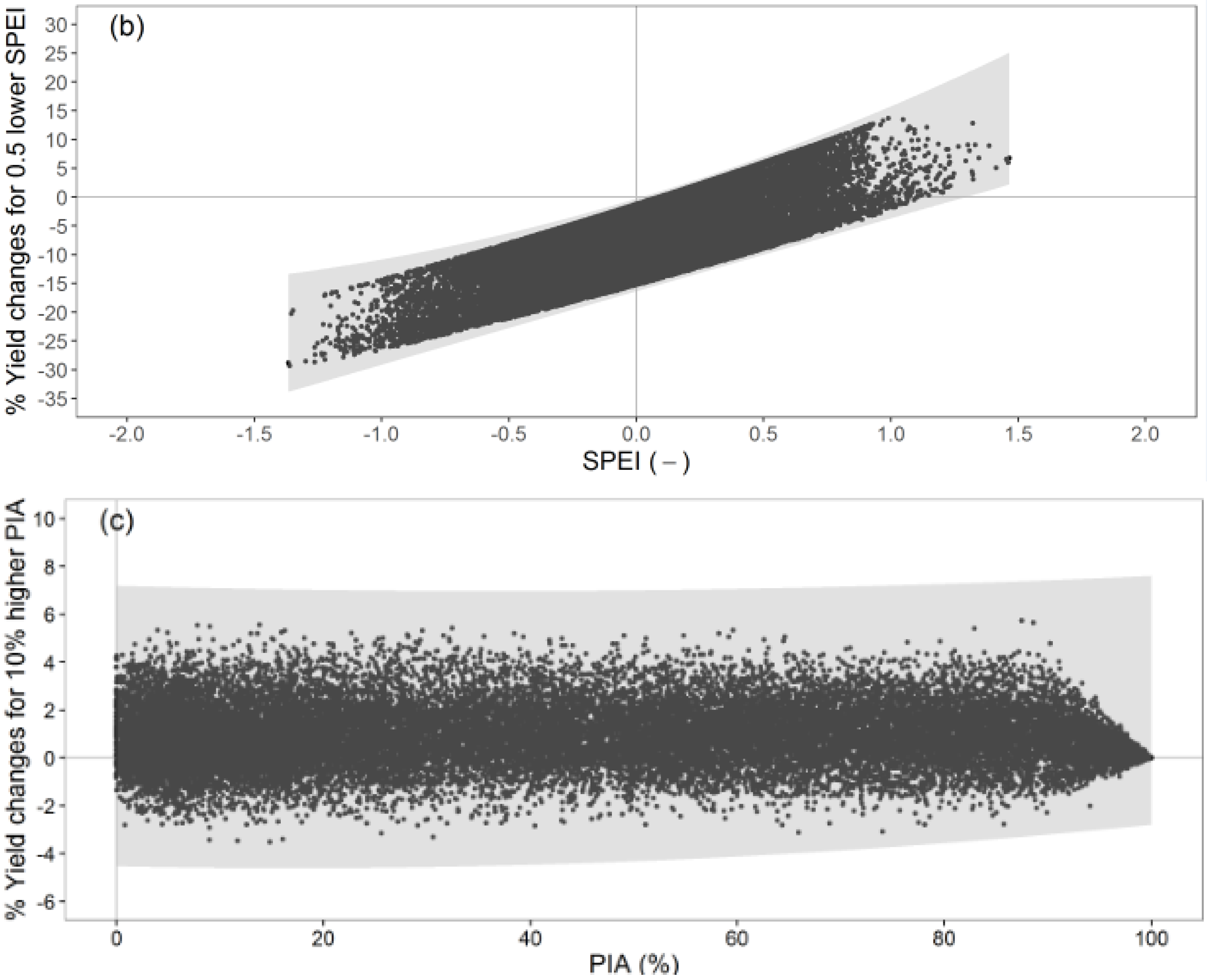Adaptive Effectiveness of Irrigated Area Expansion in Mitigating the Impacts of Climate Change on Crop Yields in Northern China †
Abstract
:1. Introduction
2. Materials and Methods
2.1. Data and Pretreatment
2.2. Statistical Model
2.3. Climate Scenarios
2.4. Irrigated Area Scenarios
3. Results
3.1. Irrigated Areas and Crop Yields under the Baseline Climate
3.2. Effects of Climate and Irrigation on Crop Yields
3.3. Future Climate Scenario
3.4. Climate Impacts on Yields under Three Irrigated Area Scenarios
4. Discussion
4.1. Yield Responses to Climate and Irrigated Areas
4.2. Future Climate Impacts and Adaptation by Expanding Irrigated Areas
4.3. Implications for the Adaptive Policies for Climate Change in China
5. Conclusions
Supplementary Materials
Acknowledgments
Author contributions
Conflicts of Interest
References
- Lin, E.; Xiong, W.; Ju, H.; Xu, Y.; Li, Y.; Bai, L.; Xie, L. Climate Change Impacts on Crop Yield and Quality with CO2 Fertilization in China. Philos. Trans. R. Soc. B 2005, 360, 2149–2154. [Google Scholar]
- Xiong, W.; Lin, E.; Ju, H.; Xu, Y. Climate Change and Critical Thresholds in China’s Food Security. Clim. Chang. 2007, 81, 205–221. [Google Scholar] [CrossRef]
- Zhang, T.; Simelton, E.; Huang, Y.; Shi, Y. A Bayesian Assessment of the Current Irrigation Water Supplies Capacity under Projected Droughts for the 2030s in China. Agric. For. Meteorol. 2013, 178, 56–65. [Google Scholar] [CrossRef]
- The Food and Agriculture Organization of the United Nations (FAO). Drought. 2015. Available online: http://www.fao.org/docrep/017/aq191e/aq191e.pdf (accessed on 12 March 2016).
- Asian Development Bank. Addressing Climate Change Risks, Disasters, and Adaptation in the People’s Republic of China; Asian Development Bank: Mandaluyong City, Philippines, 2015. [Google Scholar]
- Communist Party of China (CPC). Chinese Central Government’s Official Web Portal, China’s Spending on Water Conservation Doubles During 11th Five-Year Plan. 2011. Available online: http://www.gov.cn/jrzg/2011–01/29/content_1795245.htm (accessed on 12 March 2016).
- Yu, C. China’s water crisis needs more than words. Nature 2011, 470, 307. [Google Scholar] [CrossRef] [PubMed]
- Challinor, A.; Simelton, E.; Fraser, E.; Hemming, D.; Collins, M. Increased crop failure due to climate change: Assessing adaptation options using models and socio-economic data for wheat in China. Environ. Res. Lett. 2010, 5, 3. [Google Scholar] [CrossRef]
- Ju, H.; van der Velde, M.; Lin, E.; Xiong, W.; Li, Y. The impacts of climate change on agricultural production systems in China. Clim. Chang. 2013, 120, 313–324. [Google Scholar] [CrossRef]
- Reidsma, P.; Ewert, F.; Oude Lansink, A.; Leemans, R. Adaptation to climate change and climate variability in European agriculture: The importance of farm level responses. Eur. J. Agron. 2010, 32, 91–102. [Google Scholar] [CrossRef]
- Simelton, E.; Fraser, E.; Termansen, M.; Benton, T.; Gosling, S.; South, A. The socioeconomics of food crop production and climate change vulnerability: A global scale quantitative analysis of how grain crops are sensitive to drought. Food Secur. 2012, 4, 163–179. [Google Scholar] [CrossRef]
- Simelton, E.; Fraser, E.; Termansen, M.; Forster, P.; Dougill, A. Typologies of crop-drought vulnerability: An empirical analysis of the socio-economic factors that influence the sensitivity and resilience of drought of three major food crops in China (1961–2001). Environ. Sci. Policy 2009, 12, 438–452. [Google Scholar] [CrossRef]
- Ministry of Water Resources of China. Technical Terminology for Irrigation and Drainage; Ministry of Water Resources of China: Beijing, China, 1993; pp. 56–93.
- The Food and Agriculture Organization of the United Nations (FAO). Global Map of Irrigated Areas. 2010. Available online: http://www.fao.org/nr/water/aquastat/irrigationmap/index30.stm (accessed on 12 March 2016).
- China Meteorology Data Sharing Service. Daily climate dataset. Available online: http://cdc.nmic.cn/ (accessed on 12 March 2016).
- Thornton, P.; Running, S.; White, M.A. Generating surfaces of daily meteorological variables over large regions of complex terrain. J. Hydrol. 1997, 190, 214–251. [Google Scholar] [CrossRef]
- Zhang, T.; Huang, Y.; Yang, X. Climate warming over the past three decades has shortened 20 rice growth duration in China and cultivar shifts have further accelerated the 21 process for late rice. Glob. Chang. Biol. 2013, 19, 563–570. [Google Scholar] [CrossRef] [PubMed]
- Vicente-Serrano, S.; Begueria, S.; Lopez-Moreno, J. A multi-scalar drought index sensitive to global warming: The Standardized Precipitation Evapotranspiration Index-SPEI. J. Clim. 2010, 23, 1696–1718. [Google Scholar] [CrossRef]
- Zhang, F. Chinese Agricultural Phenology Atlas; Science Press: Beijing, China, 1987. [Google Scholar]
- Liu, B.; Asseng, S.; Müller, C.; Ewert, F.; Elliott, J.; Lobell, D.; Martre, P.; Ruane, A.; Wallach, D.; Jones, J.W.; et al. Similar estimates of temperature impacts on global wheat yield by three independent methods. Nat. Clim. Chang. 2016, 6, 1130–1136. [Google Scholar] [CrossRef]
- Lobell, D.; Burke, M.; Tebaldi, C.; Mastrandrea, M.; Falcon, W.; Naylor, R. Prioritizing climate change adaptation needs for food security in 2030. Science 2008, 319, 607–610. [Google Scholar] [CrossRef] [PubMed]
- Deng, X.; Huang, J.; Qiao, F.; Naylor, R.; Falcon, W.; Burke, M. Impacts of El Nino-Southern Oscillation events on China’s rice production. J. Geogr. Sci. 2010, 20, 3–16. [Google Scholar] [CrossRef]
- Zhang, T.; Zhu, J.; Wassmann, R. Responses of rice yields to recent climate changein China: An empirical assessment based on long-term observations at different spatial scales (1981–2005). Agric. For. Meteorol. 2010, 150, 1128–1137. [Google Scholar] [CrossRef]
- Shalizi, Z. Addressing China’s Growing Water Shortages and Associated Social and Environmental Consequences; World Bank Policy Research Working Paper: No. 3895; World Bank: Washington, DC, USA, 2006. [Google Scholar]
- Wang, S.; Zhang, Z. Effects of climate change on water resources in China. Clim. Res. 2011, 47, 77–82. [Google Scholar] [CrossRef]
- Chen, T.; Yabe, M. Study on the Formation of Household Management in Chinese Agriculture; Faculty of Agriculture Publications: Fukuoka, Japan, 2009. [Google Scholar]
- Xu, K. Why do irrigation infrastructures abandoned? Coop. Econ. China 2009, 2, 5. [Google Scholar]
- Zhang, C.; Li, D. The concept of reinforcing rural irrigation infrastructure constructions in modern China. China Rural Water Hydropower 2009, 7, 1–3. [Google Scholar]
- Chen, C.; Wang, E.; Yu, Q. Modeling wheat and maize productivity as affected by climate variation and irrigation supply in North China Plain. Agron. J. 2010, 102, 1037–1049. [Google Scholar] [CrossRef]
- Zhang, T.; Lin, X.; Sassenrath, G. Current irrigation practices in the central United States reduce drought and extreme heat impacts for maize and soybean but not for wheat. Sci. Total Environ. 2015, 508, 331–342. [Google Scholar] [CrossRef] [PubMed]
- Grassini, P.; Cassman, K. High-yield maize with large net energy yield and small global warming intensity. Proc. Natl. Acad. Sci. USA 2011, 109, 1074–1079. [Google Scholar] [CrossRef] [PubMed]
- Blanke, A.; Rozelle, S.; Lohmar, B.; Wang, J.; Huang, J. Water saving technology and saving water in China. Agric. Water Manag. 2007, 87, 139–150. [Google Scholar] [CrossRef]
- Liu, Y.; Huang, J.; Wang, J.; Rozelle, S. Determinants of agricultural water saving technology adoption: An empirical study of 10 provinces of China. Ecol. Econ. 2008, 4, 462–472. [Google Scholar]
- Cremades, R.; Wang, J.; Morris, J. Policies, Economic incentives and the adoption of modern irrigation technology in China. Earth Syst. Dyn. 2015, 6, 399–410. [Google Scholar] [CrossRef]
- Huang, Q.; Wang, J.; Li, Y. Do water saving technologies save water? Empirical evidence from North China. J. Environ. Econ. Manag. 2017, 82, 1–16. [Google Scholar] [CrossRef]
- Zhang, Q. Strategies for developing Green Super Rice. Proc. Natl. Acad. Sci. USA 2007, 104, 16402–16409. [Google Scholar] [CrossRef] [PubMed]
- Marcaida, M., III; Li, T.; Angeles, O.; Evangelista, G.; Fontanilla, M.; Xu, J. Biomass accumulation and partitioning of newly developed Green Super Rice (GSR) cultivars under drought stress during the reproductive stage. Field Crop. Res. 2014, 162, 30–38. [Google Scholar] [CrossRef]
- Chen, H.; Sun, J. Changes in drought characteristics over China using the standardized precipitation evapotranspiration index. J. Clim. 2015, 28, 5430–5447. [Google Scholar] [CrossRef]






| Provinces | ID | Rice Sowing | Harvest | Tavg | Wheat Sowing | Harvest | Tavg | Maize Sowing | Harvest | Tavg | Soybean Sowing | Harvest | Tavg |
|---|---|---|---|---|---|---|---|---|---|---|---|---|---|
| Northeast | |||||||||||||
| Heilongjiang | 1 | 1 May | 30 September | 17.5 | 1 April | 31 July | 14.8 | 1 May | 30 September | 17.5 | 1 May | 30 September | 17.5 |
| Jilin | 2 | 1 May | 30 September | 18.1 | 1 April | 31 July | 15.5 | 1 May | 30 September | 18.1 | 1 May | 30 September | 18.1 |
| Liaoning | 3 | 1 May | 30 September | 20.4 | 1 April | 31 July | 17.8 | 1 May | 30 September | 20.4 | 1 May | 30 September | 20.4 |
| North | |||||||||||||
| Beijing | 4 | 1 April | 30 September | 20.1 | 1 October | 30 Jun. | 6.5 | 1 June | 30 September | 22.5 | 1–30 June | 30 September | 22.5 |
| Hebei | 5 | 1 April | 30 September | 21.4 | 1 October | 30 June | 8.4 | 1 June | 30 September | 23.7 | 1–30 June | 30 September | 23.7 |
| Tianjin | 6 | 1 April | 30 September | 22.3 | 1 October | 30 June | 9.0 | 1 June | 30 September | 24.7 | 1–30 June | 30 September | 24.7 |
| Shandong | 7 | 1 April | 30 September | 22.0 | 1 October | 30 June | 10.0 | 1 June | 30 September | 24.5 | 1–30 June | 30 September | 24.5 |
| Henan | 8 | 1 April | 30 September | 22.6 | 1 October | 30 June | 11.4 | 1 June | 30 September | 24.8 | 1–30 June | 30 September | 24.8 |
| Inner Mongolia | 9 | 1May | 30 September | 17.0 | 1 April | 31 July | 14.7 | 1May | 30 September | 17.0 | 1May | 30 September | 17.0 |
| Northwest | |||||||||||||
| Shanxi | 10 | 1 May | 30 September | 19.2 | 1 October | 30 June | 5.5 | 1 May | 30 September | 19.2 | 1 May | 30 September | 19.2 |
| Shaanxi | 11 | 1 May | 30 September | 20.3 | 1 October | 30 June | 8.2 | 1 May | 30 September | 20.3 | 1 May | 30 September | 20.3 |
| Ningxia | 12 | 1 May | 30 September | 18.1 | 1 October | 30 June | 4.4 | 1 May | 30 September | 18.1 | 1 May | 30 September | 18.1 |
| Gansu | 13 | 1 April | 30 September | 16.0 | 1 October | 30 June | 3.8 | 1 May | 30 September | 16.0 | 1 May | 30 September | 16.0 |
| Qinghai | 14 | NA | NA | NA | 1 March | 31 July | 3.2 | 1 May | 30 September | 8.1 | 1 May | 30 September | 8.1 |
| Xinjiang | 15 | 1 May | 30 September | 17.3 | 1 October | 30 June | 1.5 | 1 May | 30 September | 17.3 | 1 May | 30 September | 17.3 |
| Variables | Regression Coefficients | t-Statistic | 95% CI |
|---|---|---|---|
| PIA | 0.000372 | 0.41 | (−0.0013,0.0019) |
| PIA2 | −4.68 × 10−6 | −1.07 | (−1.53 × 10−5,5.618 × 10−6) |
| Tavg | −0.0107 | −1.39 | (−0.031,0.0088) |
| Tavg2 | −0.00052 * | −1.84 | (−0.001,−0.0001) |
| SPEI | 0.260 *** | 36.2 | (0.24,0.28) |
| SPEI2 | −0.143 *** | −21.72 | (−0.16,−0.12) |
| PIA × Tavg | 6.66 × 10−5 ** | −25.88 | (0.00002,0.00013) |
| PIA × SPEI | −0.00306 ** | 2.08 | (−0.0033,−0.0027) |
| Sample size | 28341 | ||
| R2 | 0.9771 | ||
| F-value | 330.9 | ||
| p-value | <0.001 |
| RCP | RCP2.6 | RCP8.5 |
|---|---|---|
| Temperature change (°C) | 1.6 | 2.0 |
| SPEI change (−) | −0.2 | −0.3 |
| Percentage yield change with no change in irrigated area (%) | −4.7 | −7.3 |
| Percentage yield change with 4.4% increase in irrigated area (%) | −4.0 | −6.5 |
| Percentage yield change with 10% increase in irrigated area (%) | −3.2 | −5.5 |
| Percentage yield change with 15% increase in irrigated area (%) | −2.5 | −4.6 |
© 2017 by the authors. Licensee MDPI, Basel, Switzerland. This article is an open access article distributed under the terms and conditions of the Creative Commons Attribution (CC BY) license (http://creativecommons.org/licenses/by/4.0/).
Share and Cite
Zhang, T.; Wang, J.; Teng, Y. Adaptive Effectiveness of Irrigated Area Expansion in Mitigating the Impacts of Climate Change on Crop Yields in Northern China. Sustainability 2017, 9, 851. https://doi.org/10.3390/su9050851
Zhang T, Wang J, Teng Y. Adaptive Effectiveness of Irrigated Area Expansion in Mitigating the Impacts of Climate Change on Crop Yields in Northern China. Sustainability. 2017; 9(5):851. https://doi.org/10.3390/su9050851
Chicago/Turabian StyleZhang, Tianyi, Jinxia Wang, and Yishu Teng. 2017. "Adaptive Effectiveness of Irrigated Area Expansion in Mitigating the Impacts of Climate Change on Crop Yields in Northern China" Sustainability 9, no. 5: 851. https://doi.org/10.3390/su9050851





